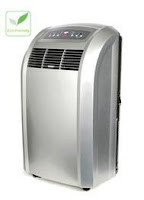 |
| Frididaire 8000 BTU Window Air Conditioner |
Many consumers think that window air conditioner units are ugly.
Manufacturers have picked up on this trend and made a big push to sell portable A/C units–which sit inside the room and are not visible through the window–as an alternative to a window AC. As a result, we have recently seen a huge spike in portable AC unit sales.
Manufacturers have picked up on this trend and made a big push to sell portable A/C units–which sit inside the room and are not visible through the window–as an alternative to a window AC. As a result, we have recently seen a huge spike in portable AC unit sales.
In some cases, apartments and condominium boards even ban the installation
of window air conditioners precisely because they are deemed to be an eyesore.
Many manufacturers tout their portable A/C units as being “windowless.” In
reality, however, this isn't exactly true.
Yes, the portable air conditioner sits inside your room and does not
rest on the windowsill. However, even a portable AC unit has to be vented
through a window or sliding door. This is necessary so that the hose from the
back of the unit can expel the hot air outside.
Although a portable AC is not windowless per se, you really can't see it
from outside of your home or building. As a result, most apartments and condos
will allow you to use one of these units, even if they ban window air
conditioners.
 |
| Koldfront 14000 BTU Portable Air Conditioner |
Is important to keep in mind that, if you are planning to purchase a
portable AC unit, it is essential that you place it in a room that will allow
you to vent through to the outside. If the portable AC unit cannot remove the
hot air and push it outdoors, it simply will not cool your room.
You will also have to rig up a system through which to feed the hose. Many
portable air conditioners come with an installation kit that consists of a
strip of plastic with a hole big enough for the hose to fit through. You are
supposed to attach the plastic to the window nearest the unit to feed the tube
out. This means, however, that you will have a white or gray plastic strip
attached to your window.
Also, because the entire air-conditioning unit is housed in one case, a portable
AC also creates heat from its compressor and condenser. This means that the
unit itself gives off a fair amount of heat. Again, this means that you must
have a way to set up the venting hose.
Bear in mind that you will have to place your portable A/C unit in a
room that will allow you to vent its outside. In other words, it will have to
be placed in a room with a window or sliding glass door.
If
you are looking to purchase a portable AC to use in a factory, however, you may
have a different option for venting.
Some
consumers purchase portable AC units to keep workers cool on the assembly line.
In this case, it's feasible to vent a portable AC unit not to the outside, but
to a different section or room of the building. This would result in keeping
the workers cool where you want them to be and directing the key to a different
space that is unoccupied.







